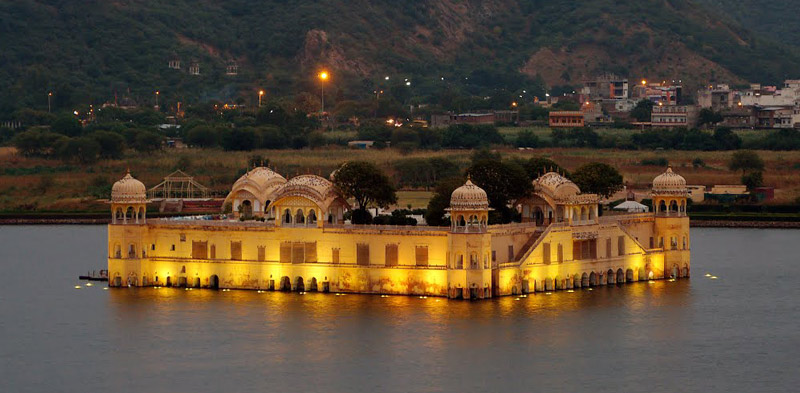
Jal Mahal
Welcome to Dubey Adventure Tours And Travel

Jaipur - Jal Mahal
The Jal Mahal palace is an architectural showcase of the Rajput style of architecture (common in Rajasthan) on a grand scale. The building has a picturesque view of the lake itself but owing to its seclusion from land is equally the focus of a viewpoint from the Man Sagar Dam on the eastern side of the lake in front of the backdrop of the surrounding Nahargarh ("tiger-abode") hills. The palace, built in red sandstone, is a five storied building, of which four floors remain underwater when the lake is full and the top floor is exposed. One rectangular Chhatri on the roof is of the Bengal type. The chhatris on the four corners are octagonal. The palace had suffered subsidence in the past and also partial seepage (plasterwork and wall damage equivalent to rising damp) because of waterlogging, which have been repaired under a restoration project of the Government of Rajasthan. The hills surrounding the lake area, towards the north east of Jaipur, have quartzite rock formations (with a thin layer of soil cover), which is part of Aravalli hills range. Rock exposures on the surface in some parts of the project area have also been used for constructing buildings. From the north east, the Kanak Vrindavan valley, where a temple complex sits, the hills slope gently towards the lake edge. Within the lake area, the ground area is made up of a thick mantle of soil, blown sand and alluvium. Forest denudation, particularly in the hilly areas, has caused soil erosion, compounded by wind and water action. As a result, silt built up in the lake incrementally raises the lake bed.
Find Us
Package -
Phone - 790 675 1043
BOOK OUR TRAVEL TOURIST
GALLERY
testimonials

Metk Manuela
Our trip through Dubey Adventure Tours And Travels to Jaipur , Pushkar, Udaipur was very nice,, services are really very good, the travel agent is very supportive and has a very good knowledge about the tourist places...

Manoj Sharma
Dubey Adventure tours and travels is nice agency to book trip, they designed my Himachal package very intellectually , assuming my family needs and comfort. people are friendly and services are hassle free. Excellent experience- would definitely recommend them.

John
It was amazing trip to India Rajasthan and Agra are beautiful places with mouth watering food and beautiful monuments friendly people.. Dubey Adventure tours and travels is one nice travel agency, services provided are awsome and one stop solution for all your travel needs. Good luck to them :)

James
Our first foreign trip through Dubey Adventure Tours And Travels to Rajasthan was very nice, services are really Commendable and Applaudable ! the packages are very economic and more important travel agent is very wise and supportive.

O William
Our first foreign trip through Dubey Adventure Tours And Travels to Jaipur was very nice, services are really Commendable and Applaudable ! the packages are very economic and more important travel agent is very wise and supportive.